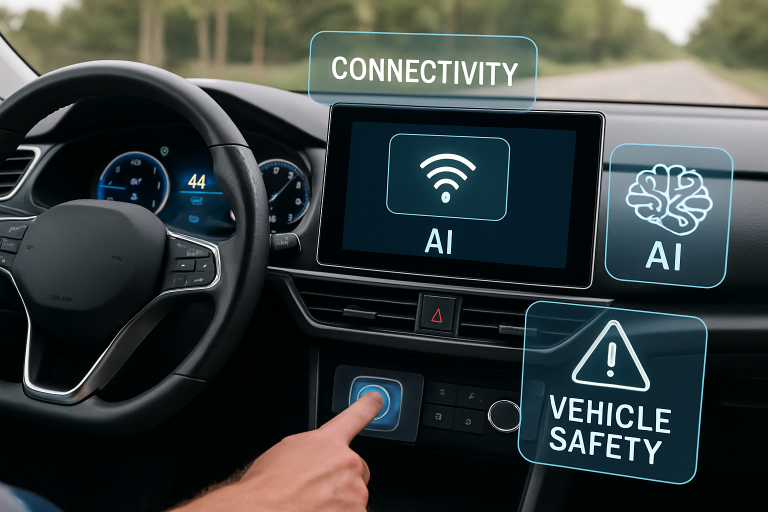Key Takeaways
- Biometric car keys offer personalized and secure vehicle access.
- Adaptive driver-assistance systems are becoming more accessible.
- AI-powered predictive maintenance enhances vehicle reliability.
- Advanced in-car displays improve driver information access.
- Enhanced internet connectivity ensures seamless on-the-go communication.
- Final Thoughts
Modern vehicles are integrating advanced technologies that not only make driving safer but also more intuitive and enjoyable. With each new generation of automobiles, drivers benefit from smarter features, tighter security, and greater connectivity—ushering in a new era of automotive innovation. Whether you’re interested in updated safety tools, transformative in-cabin experiences, or the peace of mind that comes from real-time diagnostics, the latest car tech has something for everyone. To learn more about the latest cars featuring these cutting-edge technologies, explore current offerings from trusted dealerships.
A mix of biometric security systems, artificial intelligence, and seamless integration between digital and physical environments is defining the future of driving. As these advancements steadily make their way into even entry-level models, they’re setting new standards for how we interact with and experience our vehicles.
Biometric Car Keys: Personalized and Secure Access
Traditional car keys and fobs are fading into the past as automotive manufacturers introduce sophisticated biometric access systems. New models from Hyundai and Tesla, among others, now offer facial and fingerprint recognition technology, allowing for instant, secure access without the need for a physical key. This shift not only elevates vehicle security—making it exceedingly difficult for unauthorized users to gain entry—but also enables extensive personalization. With biometric identification, cars can automatically adjust seat positions, climate controls, entertainment profiles, and even steering wheel settings to each registered user’s preferences upon entry, making every journey uniquely tailored.
Adaptive Driver-Assistance Systems: Enhancing Safety and Convenience
Adaptive driver-assistance systems (ADAS) are transforming road safety and convenience for drivers of all experience levels. Advanced systems such as Subaru’s EyeSight suite and Kia’s AI-powered voice assistant SoundHound are now standard on many vehicles, not just luxury models. These systems use sensors, cameras, and artificial intelligence to offer features like adaptive cruise control, lane-keeping assist, blind-spot monitoring, and automated emergency braking. In addition, AI voice assistants interpret natural speech, allowing drivers to control navigation, entertainment, and climate systems while keeping their focus on the road. As reported by Kiplinger, these features are becoming increasingly accessible, making them practical for daily commuting and road trips alike.
AI-Powered Predictive Maintenance: Proactive Vehicle Care
Staying up to date with vehicle maintenance has never been easier or more proactive, thanks to the adoption of AI-powered predictive maintenance systems. Platforms such as GM’s OnStar monitor various vehicle systems in real time, analyzing everything from tire pressure to engine performance, and alerting drivers to potential issues before they escalate. This technology helps car owners take preventative measures, reducing the likelihood of breakdowns and expensive repairs while also optimizing the vehicle’s overall lifespan. AI-driven maintenance not only brings convenience but also solidifies peace of mind on every journey.
Advanced In-Car Displays: Comprehensive Information at a Glance
Automotive displays have evolved far beyond standard dashboards. Today, digital cockpits and panoramic display screens, such as BMW’s Panoramic iDrive, provide a truly immersive interface. Spanning the entire width of the dashboard, these innovative displays present critical information—navigation, speed, energy consumption, infotainment, and more—at a glance. This cohesive presentation reduces distraction and allows drivers to absorb information quickly without losing focus on the road. According to Preston Ford, the trend toward expansive, intuitive display systems is likely to accelerate as connected and semi-autonomous vehicles become mainstream.

Enhanced Internet Connectivity: Seamless On-the-Go Communication
Today’s new cars are more connected than ever, with in-vehicle internet offering fast, reliable access to cloud services and entertainment. Technology firms like Stellar are deploying tri-band solutions—leveraging satellite, cellular, and Wi-Fi networks—to deliver high-speed connectivity everywhere, from urban centers to the most remote rural roads. This always-on connectivity powers everything from real-time navigation updates to streaming for rear-seat passengers, and even enables over-the-air software updates. As outlined by Moon Township Ford, this leap in connectivity paves the way for more advanced vehicle autonomy and enhances the overall experience for today’s digitally connected drivers.
Final Thoughts
The automotive world is at the cusp of a technological renaissance, driven by innovations that redefine security, safety, convenience, and connectivity. From advanced biometrics and predictive diagnostics to powerful infotainment displays and robust internet access, modern vehicles are being equipped with features that offer unparalleled benefits to drivers and passengers alike. As these groundbreaking advancements become standard across more makes and models, exploring the very latest cars and technology at trusted dealerships ensures you don’t miss out on these transformative experiences. Embracing these trends means enjoying a driving experience that is safer, smarter, and more connected than ever before.
Leave a Reply